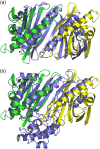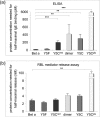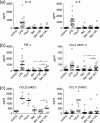Stabilization of the dimeric birch pollen allergen Bet v 1 impacts its immunological properties
- PMID: 24253036
- PMCID: PMC3879576
- DOI: 10.1074/jbc.M113.518795
Stabilization of the dimeric birch pollen allergen Bet v 1 impacts its immunological properties
Abstract
Many allergens share several biophysical characteristics, including the capability to undergo oligomerization. The dimerization mechanism in Bet v 1 and its allergenic properties are so far poorly understood. Here, we report crystal structures of dimeric Bet v 1, revealing a noncanonical incorporation of cysteine at position 5 instead of genetically encoded tyrosine. Cysteine polysulfide bridging stabilized different dimeric assemblies, depending on the polysulfide linker length. These dimers represent quaternary arrangements that are frequently observed in related proteins, reflecting their prevalence in unmodified Bet v 1. These conclusions were corroborated by characteristic immunologic properties of monomeric and dimeric allergen variants. Hereby, residue 5 could be identified as an allergenic hot spot in Bet v 1. The presented results refine fundamental principles in protein chemistry and emphasize the importance of protein modifications in understanding the molecular basis of allergenicity.
Keywords: Allergen; Crystal Structure; Dimerization; Mass Spectrometry (MS); Noncanonical Amino Acid Incorporation; Polysulfide Linking; Position-specific Alteration of Genetic Code; Post-translational Modification; Protein Assembly.
Figures










Similar articles
-
Characterization of PR-10 genes from eight Betula species and detection of Bet v 1 isoforms in birch pollen.BMC Plant Biol. 2009 Mar 3;9:24. doi: 10.1186/1471-2229-9-24. BMC Plant Biol. 2009. PMID: 19257882 Free PMC article.
-
Allergenicity and antigenicity of wild-type and mutant, monomeric, and dimeric carrot major allergen Dau c 1: destruction of conformation, not oligomerization, is the roadmap to save allergen vaccines.J Allergy Clin Immunol. 2007 Apr;119(4):944-51. doi: 10.1016/j.jaci.2006.11.699. Epub 2007 Feb 9. J Allergy Clin Immunol. 2007. PMID: 17292955
-
Structure of the major carrot allergen Dau c 1.Acta Crystallogr D Biol Crystallogr. 2009 Nov;65(Pt 11):1206-12. doi: 10.1107/S0907444909034854. Epub 2009 Oct 22. Acta Crystallogr D Biol Crystallogr. 2009. PMID: 19923716
-
[Molecular aspects of allergy to plant products. Part II. Pathogenesis-related proteins (PRs), apple allergenicity governed by Mal d 1 gene].Pol Merkur Lekarski. 2012 Mar;32(189):176-81. Pol Merkur Lekarski. 2012. PMID: 22568184 Review. Polish.
-
The History and Science of the Major Birch Pollen Allergen Bet v 1.Biomolecules. 2023 Jul 19;13(7):1151. doi: 10.3390/biom13071151. Biomolecules. 2023. PMID: 37509186 Free PMC article. Review.
Cited by
-
The impact of nitration on the structure and immunogenicity of the major birch pollen allergen Bet v 1.0101.PLoS One. 2014 Aug 15;9(8):e104520. doi: 10.1371/journal.pone.0104520. eCollection 2014. PLoS One. 2014. PMID: 25126882 Free PMC article.
-
Effect of tomato variety, cultivation, climate and processing on Sola l 4, an allergen from Solanum lycopersicum.PLoS One. 2018 Jun 14;13(6):e0197971. doi: 10.1371/journal.pone.0197971. eCollection 2018. PLoS One. 2018. PMID: 29902173 Free PMC article.
-
Folded or Not? Tracking Bet v 1 Conformation in Recombinant Allergen Preparations.PLoS One. 2015 Jul 17;10(7):e0132956. doi: 10.1371/journal.pone.0132956. eCollection 2015. PLoS One. 2015. PMID: 26186356 Free PMC article.
-
Identification and analysis of major latex protein (MLP) family genes in Rosa chinensis responsive to Botrytis cinerea infection by RNA-seq approaches.Front Plant Sci. 2024 Dec 13;15:1511597. doi: 10.3389/fpls.2024.1511597. eCollection 2024. Front Plant Sci. 2024. PMID: 39735770 Free PMC article.
-
Oligomerization and tyrosine nitration enhance the allergenic potential of the birch and grass pollen allergens Bet v 1 and Phl p 5.Front Allergy. 2023 Dec 5;4:1303943. doi: 10.3389/falgy.2023.1303943. eCollection 2023. Front Allergy. 2023. PMID: 38125293 Free PMC article. Review.
References
-
- Shakib F., Ghaemmaghami A. M., Sewell H. F. (2008) The molecular basis of allergenicity. Trends Immunol. 29, 633–642 - PubMed
-
- Lascombe M. B., Grégoire C., Poncet P., Tavares G. A., Rosinski-Chupin I., Rabillon J., Goubran-Botros H., Mazié J. C., David B., Alzari P. M. (2000) Crystal structure of the allergen Equ c 1. A dimeric lipocalin with restricted IgE-reactive epitopes. J. Biol. Chem. 275, 21572–21577 - PubMed
Publication types
MeSH terms
Substances
Associated data
- Actions
- Actions
- Actions
- Actions
Grants and funding
LinkOut - more resources
Full Text Sources
Other Literature Sources

